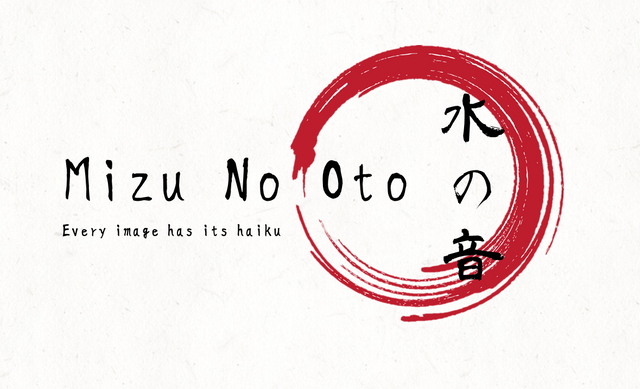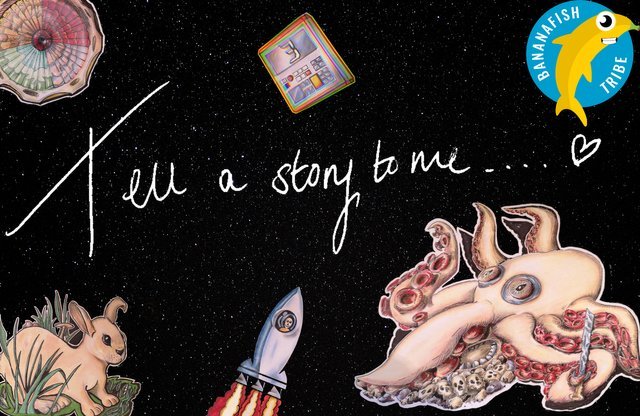Mizu No Oto - Every Image Has Its Haiku - Edition #35 (English)

haiku by Neni Rusliana (Indonesia)
Welcome to the late July-August English edition of the Bananafish haiku contest!
Since the stars are aligned and I can also finally go on vacation, in August there will be only one edition in Spanish, and the next one in English will be at the beginning of September.
Here is how this contest works:
A photo is posted.
You write a haiku inspired by that photo with your own post (use #haikucontest as your first tag) or a comment in the comment section.
You can read other’s haiku and vote for one of them, answering to the special Bananafish comment in the comment section.
The authors of the Best Haiku, Popular Choice, and Best Vote Comment WIN 5 STEEM, 5 SBI & 1000 SNAX!
@f3nix tireless work and the vital support by @curie and @crowdmind allow us to increase the amount of prizes up for grabs, which continue to include the SNAX token (see below).

The Prizes:
Courtesy of our partners, @Crowdmind, we're now also giving away SNAX tokens!
Check out Crowdmind's Interview with the team from the SNAX blockchain as well as our previous post.
To receive your SNAX rewards, you'll need to have a SNAX wallet. The best one so far is Nabla app.
Otherwise, you can use Snax.One
Here's a tutorial with photos. on how to set a Snax.One wallet.
So, the prizes now are:

The requirements:
• The haiku should be related to the prompt image.
• A haiku has no title.
• The haiku should be in English, or include an English translation.
• The English haiku form is: a short (3-4 syllable) verse, a longer (5-6 syllable) verse, another short (3-4 syllable) verse.
• There should be the kireji (切れ字), a cut between the 1st and the 2nd verses, or between the 2nd and the 3rd; the cut can be grammatical, as a sign of punctuation, or it can be a cut in the meaning, like two different images.
• The time window to post your haiku and cast your votes is up to the payout of this post.

Prompt Image:

[photo with kind permission of Tiziana Dan]

Do you want to know how we evaluate the submitted haiku? These are the characteristics we search for:
• Kigo (季語), an explicit or implicit reference to a season, that defines the time of the year in which the haiku is composed or referred to.
• Sabi (寂), the sense of the inexorable passage of time, the beauty or serenity that accompanies the advance of age, when the life of the objects and its impermanence are highlighted by patina and wear or by any visible repairs.
• Wabi (侘寂), the taste for frugal and natural things, rustic simplicity, freshness or silence; it can be applied to both natural and artificial objects, or even non-ostentatious elegance.
• Mono no aware (物の哀れ), empathy with nature and human life; the "feeling of things", nostalgia, regret for the passing of time, understanding of the changeability and of the transience without suffering.
• Yūgen (幽玄), sense of wonder and mystery; it represents the state of mind produced by the inexplicable fascination of things, the feeling of an 'other' universe, full of mysterious unity.
• Karumi (軽み), beauty in simplicity; poetic beauty reflected in its simplicity, free from preconceptions and moral judgment.
• Shiori (しおり), gentleness; the levity and the delicate charm that radiates from the verses, where things are evoked in the reader without aggressiveness or excessive explicitness.

The Fūryū: the Mono no Aware
In this theoretical part, we continue our excursus on the concepts that form thefūryū, the poetic essence of the haiku.
The concept of mono no aware (物の哀れ, the feeling of things) is very close to what we call empathy. It can be used to refer to all manifestations of human emotionality, both positive and negative, from amazement, to wonder, to sadness, to melancholy.
In fact, the word aware, originally was nothing but an exclamation that was pronounced every time a great emotion was felt. Its etymology is partly onomatopoeic and derives from the ancient Japanese "aa e hare" (ah, what a moon!). This exclamation has become, with time, a way of saying that was extended to any emotional context.
So, everything would seem very simple and vague, but it is not so. To complicate matters, the Japanese culture intervenes, through which such universal feeling is elaborated.
First, Shinto sensitivity, with its attention to the natural world and its essence. This is where we meet the other half of the concept of mono no aware. In fact, two facets of Shinto religious sentiment towards nature are the mono no ke (the vitality of things) and the mono no kokoro (the spirit of things).
Mono no ke refers to the vital energy that flows in all the things belonging to the material world, also and above all the simpler and smaller ones (an insect, a leaf, an old shoe on the bottom of a stream); vital energy is in all things, but greater sensitivity is needed to capture it in trivial and humble things.
Mono no kokoro refers, instead, to the resonance between the human soul and the nature in which it is immersed; here too, the greater the sensitivity, the more intense the spiritual communion.
These two concepts have therefore merged into mono no aware, giving a more precise direction to the "feeling of things": a poetic sensitivity that allows the individual to be in harmony with all things and spontaneously empathize with their vital energy.
The last step was when this concept was filtered through Buddhist thought. Buddhism was introduced in Japan in the sixth century, but for many centuries it remained confined to courts and intellectual circles. When haiku develops as a form of autonomous poetry, a thousand years later, Buddhism has slowly permeated many aspects of Japanese thought.
Therefore, the Buddhist concepts of impermanence and transience of all things in the world are linked to mono no aware. Then, we can say that the mono no aware, in its final formulation, is a poetic sensitivity that allows us to embrace naturalistic reality in any form it appears, in full awareness that everything is fragile, evanescent and temporary.
This, it is worth repeating, does not give rise to negative feelings, but to commotion and participation watching a delicate beauty, that can melt like snow in the sun.
Thank you for reading this little study, next time we'll talk about the mysterious yūgen.

Good haiku to everybody!
Your bananafishously haiku dealer


Let’s the Bananafish Tribe grow together!

With delegations, Bananafish VP will grow and consequently the upvotes given to every contest entry will be higher.
Following the voting trail is a way to make sure you always support the other participants to the Bananafish contests, automatically upvoting the posts (but not the comments) Bananafish upvotes.
Join the Bananafish Realms on Discord and chat with us: https://discord.gg/ZWmEUWT
If you’re interested, here you can find all the information needed.

[banner credit: @f3nix]
Other Bananafish awesome contests and creative works (click on the banners):





Hi Marco,
I'm not in the mood for the city, as my haiku will show :)I just looked at you syllable count. I thought 5/7/5 was classic haiku. However, if that is not right, the second version will serve. This has the 3/5/3 count. Same sense, less words :)
Dissonance. Bustle.
Red. White. Black. Grey. The city.
Flowers blossom---where?
Dissonance
White. Grey. The City.
Flowers--Where?
Enjoyed your haiku @agmoore. Had to go back and look at the picture to find all the colors. Yes, the city void of nature.
Nice to see you here, @cyemela. Always a good day when you stop by.
I also prefer the second one: it contains everything you said with the first, but in a more economical and simpler way.
I'm a bit sorry for the fact that the city triggers negative reactions in you, but I accept it.
While I was born in a hospital :), the next eleven years were spent in the shadow of a forest. The city was a shock. I think as I get older, the early impressions prevail. Nature is my comfort zone.
@agmoore, your haiku is very city. I really like the way you choose to write the second one.
Thanks. Yeah, I like the second one better too.
I thought 5-7-5 was classic too. Like the first version and second 💕
Thank you!
Vote for your favorite haiku down here
A little withdrawn from participation by all the problems we faced in Vnezuela (and, in particular, my city, Cumaná), I try to give my brief and light appreciation on the concurrent exercises.
I have read some very good ones, but in my poetic optics (perhaps not so haiku), I would choose the exercises of @salvao, @zeleiracordero and @oacevedo. Among those three, it is difficult for me to select; I would keep @zeleira and @oacevedo; both seem to me to collect, in the language of the poetic synthesis of haiku (in my little knowledge of it), what could be more suitable. Now, according to the jury, as in all historical cases (and I speak with propriety), subjectivity will prevail.
Greetings.
Thank you, my friend! Your participation means a lot for us, giving the big problems you're experiencing.
Thank you, @josemalavem!
@owasco got my vote with "soul seeps even through rock"...
oh my goodness thank you! this is my favorite thing to do on steem, write haiku for mizu no oto. Nice to see you here!
Greetings, haiku lovers. Tiziana Dan Photography has caused two types of reactions. On the one hand it has generated an expressiveness contrary to the big cities, where the presence of "nature" (trees, flowers, silence) is claimed. @agmoore effectively summarizes this perception. On the other hand, others have seen in the photograph an intangible presence: a soul that moves through the rocks (@owasco), a spirit that remains intact @darthgexe ... in this last vision I sign up and therefore my favorite haiku this week is the one of @salvao, in him I find a symbolic handling of the notion of church and the affirmation that this lost stone remains in our human conscience (it could also be unconsciously) maintaining the search for what cannot easily be built in stone, but that makes us deeply human.
My vote for @salvao.
Thank you very much for your assessment and for your vote. The truth is that I enjoyed building the poem with the image of this edition. Regards!
One of the best I have read, combines both English and Spanish, photography really impacts, this stone church contrasts with the large buildings that surround it, who would not stop to see it, there in that corner, imposing, Surrounded by so much noise is a cozy place, which calls to spend and pray a few minutes.
The one I like the most so far is that of
@salvao
La que más me gusta hasta ahora es la de
@salvao
Hermosa fotografía Tiziana Beautiful photography Tiziana
Uno de los mejores que he leído, combina tanto en inglés como en español, la fotografía de verdad impacta, esta iglesia de piedra hace contraste con los grande edificios que la rodean, quien no se detendría a verla, allí en esa esquina, imponente, rodeada de tanto ruido es un lugar acogedor, que llama a pasar y orar unos minutos.
https://steemit.com/spanish/@sacra97/my-entry-for-mizu-no-oto-35-english-edition-esp-eng
Faith corner
run continuously,
hey bike.
Esquina de fe
movimiento continuo,
bicicleta saluda.
Please can I vote for @zeleiracordero - there were some strong contenders, but this one has something evocative that stuck with me after reading it.
Thank you, @calluna!
My vote is for @agmoore
I did start working on entries, but totally slipped my mind. I feel like I was on the verge of something better, but I only had one finished. I wrote it as 5/7/5 and have only just noticed it doesn't count anymore, I missed the deadline anyway so hopefully i can get away with it this time ;)
Life always flowed here.
Footsteps wore this road through dirt
From the city seed.
You're still in time, payout is in 8 hours ;)
Writing in 5/7/5 is still legitimate, but there are many reasons to prefer a shorter measure. However, it is only a questionable current of thought that I have used as a model for the competition. Thanks for your haiku!
oh nooo!! Ohhh I thought i had deleted this but my connection was slow, I am so so sorry!
Ooops! But, why? It's a good haiku!
Thank you for your contribution to the crowd. We are the Steem community project dedicated to empowering The Wisdom of Crowds. You can find more about us on our official website or whitepaper and you can support us by voting for our witness and joining our curation trail on Steemauto . We are also inviting you to join Crowdmind Discord server. Don't forget to use the #crowdmind hashtag and happy crowdsourcing!
I am so pleased you offer this contest. It is my favorite thing on steem. Here is my entry:
undaunted
soul seeps even through rock
and moves along
https://steempeak.com/haikucontest/@owasco/mizu-no-oto-every-image-has-its-haiku-edition-35-english
My entire process is also in this link.
Haiku lovers:
I leave my exercise and my entry to the contest this week. https://steemit.com/steempress/@gracielaacevedo/mizunooto-everyimagehasitshaiku-edition35english-i4k0uylrkf
It is a pleasure to read them.
sacred, profane...
Human facts.
Hello potassium holders, I'm back, and here's my entry for this week.
City covers,
Immutable spirit!
Remains intact
https://steempeak.com/haikucontest/@darthgexe/mizu-no-oto-every-image-has-its-haiku-edition-35-english
I thought that the haiku in English used the structure 5-7-5 the same as in Spanish, at least that's how @haikubot reviews it. This time I made my haiku with a structure 4-6-4 and it seems a lie but the fewer syllables we use the harder it is to write the poem.
I come from a Romance language, like you, and always felt that 5/7/5 syllables were too much in English. My Italian haikus, once translated in English, needed less syllables.
English 17 syllable haiku seemed to me, mostly, awkward, since packing a lot of words and concepts in a haiku is quite a bad thing; on the contrary, Italian or Spanish haiku seemed to me right like Japanese.
Later, I met in my readings the same opinion I was developing, expressed by much more eminent haiku scholars than me, in particular: bilingual Japanese-American poet Keiko Imaoka, British and American literature professor at Kumamoto University Richard Gilbert, and USA haiku poet, translator and editor Jane Reichhold.
All these agreed in saying that English language is more concise than Japanese or Romance languages, so 17 syllables are too much for a haiku, leading to a deep misunderstanding of this form of poetry ;)
The 3-4/5-6/3-4 form comes from their articles and studies.
Personally, I find 3-5-3 perfect for my English haikus ;)
It's very interesting what you're saying, and I didn't know anything about it.
I also agree, English is much more direct than our romance languages and fewer words are needed to say the same thing, and in this case, it makes sense to use fewer syllables to express a haiku.
Please don't think I was complaining about the number of syllables, it's just that called my attention and didn't know why it should be done that way, and then I was getting used (erroneously I think) to doing haikus with the metric 5-7-5.
Thank you very much for the explanation Marco, now I understand a little more about haiku in English
I didn't think you were complaining, my friend. I've been olny carried away a little with the explanation... ;)
Oh, my! It feels so good to be back.
I was immediately inspired by the picture. If it is not New York, which is one of my favorite cities ever to walk around in, you're going to have to tell me where this picture was taken.
https://steempeak.com/haikucontest/@tristancarax/tireless-walks
It's Toronto ;)
Greetings, poets! This is my participation in the haiku challenge:
https://steemit.com/steempress/@zeleiracordero/mizunooto-everyimagehasitshaiku-edition35english-58utekyhn2
Hi! :) here my poem for this week:
https://steemit.com/spanish/@salvao/myentryformizunooto35englisheditionespeng-x4mfl4cyty
Piedra perdida,
tradiciones grabadas
en nuestra psique.
Lost stone,
engraved traditions
in our psyche.